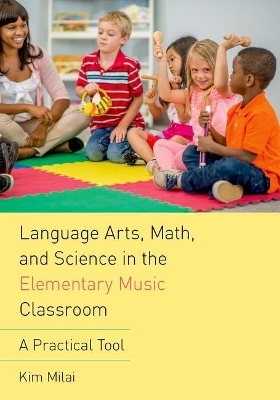
Language Arts, Math, and Science in the Elementary Music Classroom
Oxford University Press Inc (Verlag)
978-0-19-066188-5 (ISBN)
In order to maximize comprehension, the book includes assessment tests, sheet music, work sheet templates, and brainstorming activities centered on using technology to enhance composition projects. Lesson plans are organized by the calendar year, each inspired by the seasons, American culture, and world culture. These lessons may be used as is or used to generate new curricula altogether.
Kim Milai has worked as an elementary music teacher in public and private schools for the past twenty-five years. As well as being a NYC rock drummer in bands that opened for groups like the B52's, Cindy Lauper and Living Colour, she produced and performed in her own children's music CD, Dinobone, Dinobone, Have You Heard?. She has Kodály training along with certification in Suzuki flute 1A and 1B. Kim earned a Masters in Music Education at the Eastman School of Music and currently lives with her husband and two children at the foothills of the Blue Ridge Mountains of Virginia.
Dedication
Acknowledgements
Part One: Introduction
The Elementary Class: Transitioning to the Future
Using the National Core Arts Music Standards as a Tool
Subject Integration
What is STEM and NGSS?
A Word About STEAM
What This Practical Guide Includes
Rationale: How is the Music Class Evolving?
My Philosophy of Music Education: The Body/Brain Connection
Teaching Examples
Pedagogy
Why should we be open to adding other subjects within the music lesson?
To Discuss or Complete
Part Two: Lesson Plans
Lesson Overview
How to Get Started: The Process in Metaphor
Leaving the Metaphor
National Core Arts Music Standards
Tips on Creating Questions
Lesson Building Blocks
Include Popular Music
Composition and Improvisation: Where Do They Fit Into the New Standards?
Integrating Basic Subjects with the Music Curriculum
The Class
To Discuss or Complete
Keys
Kindergarten
September 1-4
October 5-8
November 9-12
December 13-16
January 17-20
February 21-24
March 25-28
April 29-32
May 33-36
Kindergarten Resources
KINDERGARTEN GROUP MUSIC ASSESSMENT TEST
KINDERGARTEN CONCEPT CODE MATRIX
Kindergarten Song List
First Grade
September 1-4
October 5-8
November 9-12
December 13-16
January 17-20
February 21-24
March 25-28
April 29-32
May 33-36
FIRST GRADE GROUP MUSIC ASSESSMENT TEST
FIRST GRADE CONCEPT CODE MATRIX
First Grade Song List
Second Grade
September 1-4
October 5-8
November 9-12
December 13-16
January 17-20
February 21-24
March 25-28
April 29-32
May 33-36
SECOND GRADE GROUP MUSIC ASSESSMENT TEST
SECOND GRADE CONCEPT CODE MATRIX
Second Grade Song List
Acoustics: Definitions
Acoustics: Decibels
Composer Unit
Turn the Glasses Over
Part Three: Songs
Song List
Part Four: Coded Concepts
Overview
Music
Math
Language Arts
Science
Social Studies
Part Five: Appendix
American and World Culture Month to Month
Assembly and Concert Suggestions
Bibliography
Classical and Folk Listening Lists
Copyright Information
Lesson Template
Group Exploration: Descriptive Music Words
National Recess Week
Online Support
Music Notation Printouts
Storybooks and Picture Books
Indexes
| Erscheinungsdatum | 28.09.2017 |
|---|---|
| Zusatzinfo | 248 line art; 15 halftones |
| Verlagsort | New York |
| Sprache | englisch |
| Maße | 254 x 175 mm |
| Gewicht | 612 g |
| Themenwelt | Kunst / Musik / Theater ► Musik ► Musiktheorie / Musiklehre |
| Schulbuch / Wörterbuch | |
| Sozialwissenschaften ► Pädagogik ► Schulpädagogik / Grundschule | |
| Sozialwissenschaften ► Pädagogik ► Vorschulpädagogik | |
| ISBN-10 | 0-19-066188-7 / 0190661887 |
| ISBN-13 | 978-0-19-066188-5 / 9780190661885 |
| Zustand | Neuware |
| Haben Sie eine Frage zum Produkt? |
aus dem Bereich


